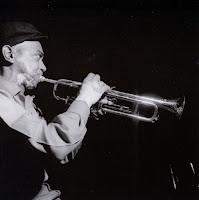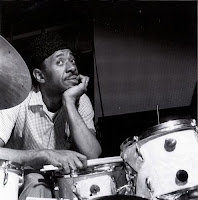Tina Brooks - The Waiting Game
Released - 1999/2002/2021
Recording and Session Information
Van Gelder Studio, Englewood Cliffs, NJ, March 2, 1961
Johnny Coles, trumpet; Tina Brooks, tenor sax; Kenny Drew, piano; Wilbur Ware, bass; Philly Joe Jones, drums.
tk.1 Dhyana
tk.6 The Waiting Game
tk.7 Talkin' About
tk.19 David The King
tk.21 One For Myrtle
tk.22 Stranger In Paradise
Session Photos
Photos: Francis Wolff
Track Listing
| Side One | ||
| Title | Author | Recording Date |
| Talkin' About | Tina Brooks | March 2 1961 |
| One For Myrtle | Tina Brooks | March 2 1961 |
| Dhyana | Tina Brooks | March 2 1961 |
| Side Two | ||
| David The King | Tina Brooks | March 2 1961 |
| Stranger In Paradise | Borodin-Forrest-Wright | March 2 1961 |
| The Waiting Game | Tina Brooks | March 2 1961 |
Liner Notes
TINA BROOKS's story, though in the extreme, is one heard all too often in jazz world: personal pain, career frustrations, public ignorance or indifference, drug abuse, early death and belated posthumous recognition. Harold "Tina" Brooks and his twin brother Harry were born in Fayetteville, North Carolina on June 7, 1932, the youngest of eight children. In 1944, the family moved to New York City. Shy, short and hardly streetwise, Tina was harassed by gangs and once mugged and robbed of his saxophone, so he moved back to Fayetteville for all but his last year of schooling.
When he graduated in 1949, he was already working professionally at dances and social functions. The next year, he replaced his older brother David "Bubba" Brooks (by that time an established tenor saxophonist in certain circles) in Sonny Thompson's R & B band. Stints with Charles Brown, Joe Morris and Amos Milburn followed until Tina tired of the relentless touring. In 1955, he joined Lionel Hampton briefly, but his taste was moving toward small-group modern jazz. Toward that end, he began to study theory and harmony.
In 1956, Brooks met the legendary bebop trumpeter Little Bennie Harris at the Blue Morocco in the Bronx. Harris schooled him in the intricacies of modern jazz, introduced him to kindred spirits like Elmo Hope and later brought him to the attention of Blue Note's Alfred Lion. Jimmy Lyons, Herman Riley, Junior Cook, Bill Hardman, Oliver Beener and Les Spann were among the group of musicians that Tina ran with, jamming in various Harlem and Bronx clubs.
Honing his skills at countless jazz sessions and absorbing the achievements of such influences as Lester Young, Wardell Gray and Hank Mobley, Tina developed a style of his own. His sound was lyrical and distinctive, his notes distinct and articulated and his ideas shaped and flowing. Trumpeter Oliver Beener, one of his closet friends, called him "a sentimentalist — his favorite tune was 'My Devotion' — and especially on the blues, Tina's tone sounded like a prayer." An excellent description of the exceptional beauty that came out of Brook's tenor.
Although he'd been on Sonny Thompson and Amos Millburn record dates in the early fifties, his first appearance as an improvising jazz artist was on the February 25, 1958 Jimmy Smith session for Blue Note that produced the 20-minute blues classic "The Sermon." Except for a Howard McGhee album on Felsted, all of Brooks's recorded output would be on Blue Note. Given his talent and the recording activity of the late fifties, it's surprising that he did not appear elsewhere. And despite Alfred Lion's support and belief in the saxophonist, some of what Tina recorded for Blue Note as a sideman and three of the four albums he made as a leader sat in the vaults until the 1980s.
Three weeks after his performance on the Jimmy Smith date, Tina was recording his first album with Lee Morgan, Sonny Clark, Doug Watkins and Art Blakey. but the album, which came to be known as Minor Move, wasn't released. Nor was a live Jimmy Smith recording at Small's Paradise a month later, which was ultimately issued as Cool Blues. Then in May, Kenny Burrell mode a marathon session featuring Tina that was issued as Blues Lights Volumes One And Two.
Tina's next appearance came in August of the next year when he and Art Blakey were added for several tunes on Kenny Burrell's The Five Spot Café. On June 19, 1960, Tina appeared on Freddie Hubbard's first album Open Sesame, contributing tunes and arrangements as well as superb solos. Freddie returned the favor a week later for Tina's first issued album True Blue. At the time, Tino was Jackie McLean's understudy in the Freddie Redd Quartet, which appeared on stage nightly in the Jack Gelber play The Connection. And that August, Redd used both Brooks and McLean on his Shades Of Redd album of Redd's score to The Connection).
On September 1, Jackie McLean assembled a sextet with Brooks, Blue Mitchell, Kenny Drew, Paul Chambers and Art Taylor for a wonderful session, half of which would be used on Jackie's Bag. Seven weeks later, Brooks would use the same sideman for his next Blue Note album. When they couldn't get a satisfactory take on one original, "David The King," Blue Note borrowed "Street Singer," a Brooks original from the McLean sextet session, to complete the album, which was entitled Back To The Tracks, given a catalog number, pictured on inner sleeves and listed in catalogs, but never released!
In January 1961, he and McLean appeared on Freddie Redd's third album, Redd's Blues, which was not issued at the time. In March, Tina made his fourth album as a leader, which was edited and sequenced, but again not issued. Both were ultimately issued in the mid-'80s on Mosaic and make their first Blue Note appearances now. They were his last sessions.
Tina's final album is now appropriately called The Waiting Game since he died in 1974 waiting for three of his four albums to be issued. With the exception of Philly Joe Jones, the personnel was not made up of frequent Blue Note contributors.
This date was, in fact, the first Blue Note appearance of Johnny Coles, who'd already made a name for himself in the bands of Gil Evans and James Moody. His playing is so strong and lyrical on this session that it's amazing that Alfred Lion did not use him more often. The fact that he was signed to Epic and would make his first album, The Warm Sound Of Johnny Coles, a month later may have had something to do with it. In 1963, he appeared on Horace Parlan's Happy Frame Of Mind and Grant Green's Am I Blue and made his own Blue Note album Little Johnny C. He would not reappear on the label until April 1969 as a member of Herbie Hancock's sextet on The Prisoner.
Kenny Drew, though not a frequent contributor to Blue Note, was an important one. He made his recording debut on the label in 1950 as part of Howard McGhee's All-Stars. He also made his first album as a leader for the label, Introducing The Kenny Drew Trio in 1953. His next appearance was four years later on one of the greatest albums in jazz history, John Coltrane's Blue Train. In 1960, he appeared on the Jackie's Bag and Back To The Tracks session and finished the year with his own Blue Note album Undercurrent. The next year, he cut this Brooks date, Dexter Gordon's Dexter Calling and Grant Green's Sunday Mornin'. He moved to Copenhagen in 1964 where he remained for the rest of his life. That June, he participated in Dexter Gordon's One Flight Up, done in Paris.
Like Drew, Wilbur Ware was in a short-lived edition of Art Blakey's Jazz Messengers that featured Ira Sullivan on tenor saxophone. It brought the great bassist from Chicago to New York. One of his first sessions was J.R. Monterose's Blue Note album, which also included Ira Sullivan and Blakey, followed by Lee Morgan's debut Indeed!. In 1957, Ware made his name with the Thelonious Monk Quartet and recorded for Blue Note on several important albums: Hank Mobley's Hank, Sonny Clark's Dial S For Sonny and Sonny Rollins's masterpiece A Night At The Village Vanguard. A frequent contributor to Riverside sessions, Ware's next appearance for Blue Note was this Brooks session; his final one was a haunting Grant Green trio session five month later that was ultimately issued in Japan as Remembering and, more recently, as Standards.
Philly Joe Jones's contributions to Blue Note are too numerous to mention. They began in 1953 with Lou Donaldson-Clifford Brown and Elmo Hope sessions and continued until Hank Mobley's The Flip, recorded in Paris in 1969. With Miles Davis, Bill Evans and his own groups and on countless record dates by all the jazz greats, Philly Joe was a consummate drummer with an incredible sense of swing and musical literacy that added dimension to every situation.
With the exception of "Stranger In Paradise," this is a program of Tina Brooks originals. "Talkin' About" is a minor riff blues with a shuffle beat. Coles solos first effectively using half-valve techniques evocative of Clark Terry. The equally soulful Brooks and Drew follow. This is the kind of groove that Alfred Lion loved.
"One For Myrtle" is a burner, paced so fast that there is time for all five men to solo. Tina is first and he's simply dazzling. "Dhyana" is a minor swinger; listen to the long lines that Brooks develops so fluidly in his solo.
"David The King", attempted without success on "Back To The Track," has a Middle Eastern fiavor that would lead one to believe that this is named after the biblical king. But surely, Brooks intended a nod to his supportive father and mentor older brother. An especially strong Coles takes the first solo, followed by Tina, Kenny and Wilbur.
Tina has the melody to himself on "Stranger In Paradise", which is taken up-tempo with a rhumba beat under the bridge. Coles, Brooks and Drew solo in that order. "The Waiting Game" with a 12-bar A section and a-bar bridge, has magnificent solos from Brooks, Coles (developing nice long lines) and Drew.
Alfred Lion felt that the ensembles on Minor Move were too ragged, not up to Blue Note standards and chose not to release it. The second album True Blue was issued. Tina followed it with two exceptional albums, Back To The Tracks and this one. Both were prepared for release, but neither appeared. Perhaps the sales of True Blue were so low that the independent label feared losing money by releasing them; Lion did not remember the circumstances when I asked him. But they are now available and ours to cherish.
It is a crime that Tina Brooks was not appreciated in his time, by music lovers or by himself. He never recorded after 1961; there was the occasional out-of-town gig like a Yale University concert with Herbie Nichols and Roswell Rudd in 1960 and a brief tour with Ray Charles's band. But primarily, Tina continued to play around the Bronx with creative musicians like Beener, Elmo Hope, Charles Tolliver, Don Pullen and Barry Altschul and did Latin and R&B gigs in the area to pay the rent. Ultimately, frustration and heroin got the better of him. When he died of kidney failure on August 13, 1974, he had not been able to play saxophone for several years. The final irony: his gorgeous voice was silenced long before he found any peace in death.
-MICHAEL CUSCUNA
Original Sessions Produced by ALFRED LION
Recorded on March 2, 1961 at Van Gelder Studios, Englewood Cliffs, New Jersey
Recording Engineer RUDY VAN GELDER
Cover Design by KAORU TAKU
Photography FRANCIS WOLFF - Mosaic Images, LLC
LP Reissue Supervision by JOE HARLEY
LP Mastering by KEVIN GRAY, Cohearent Audio









No comments:
Post a Comment